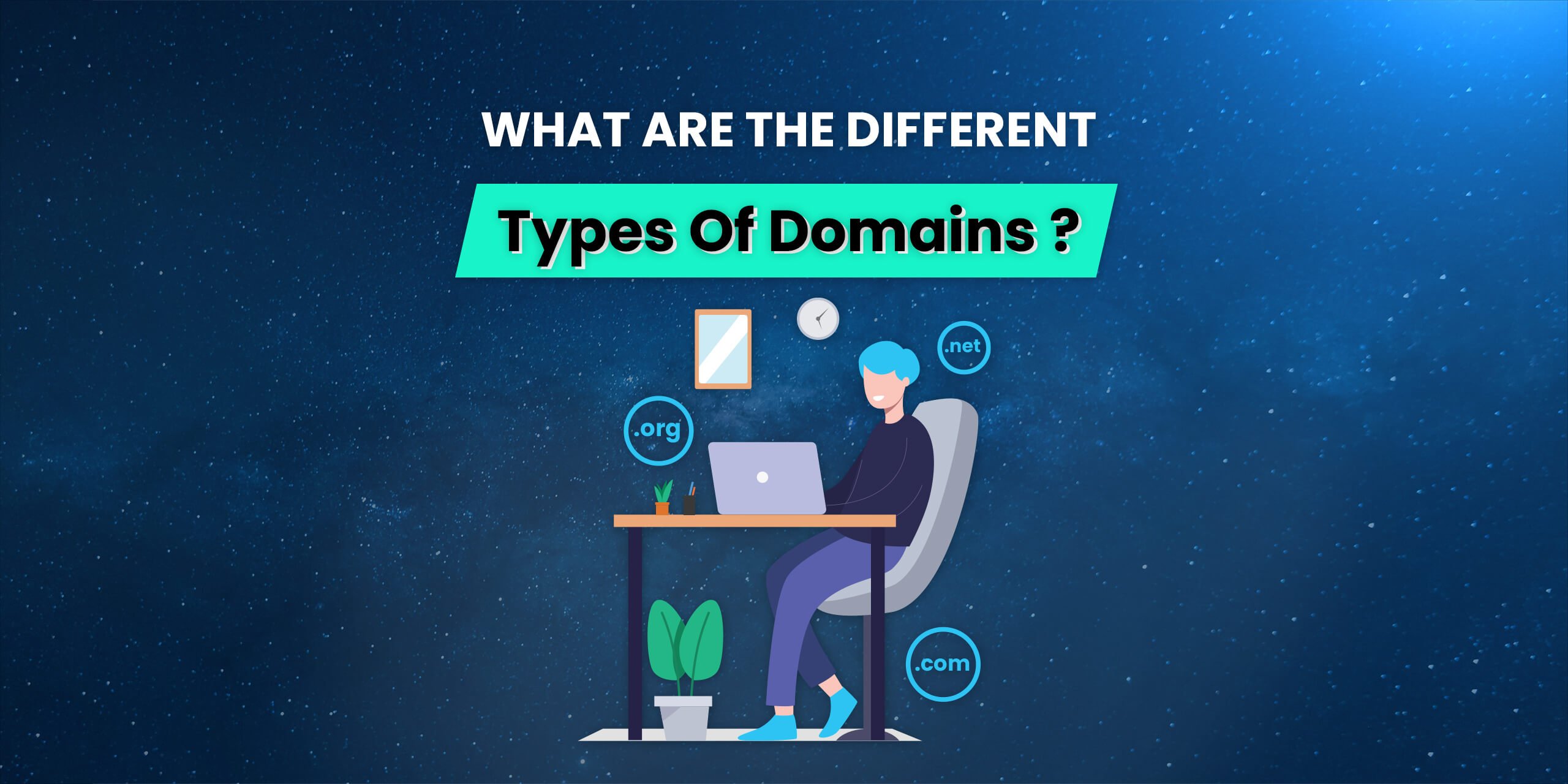The name of the site is supposed to be the first thing people see when they will be owning a website or an online store. In the new era, your domain name indicates your brand. In fact, coming up with a name is not an easy task. It is necessary to have a memorable and brandable domain name, as well as the appropriate type of domain for your website.

The domain name is the first step to building your online business and it’s important to choose one that will work well with both users as well as search engines. In this article, we will define domains and explain how to select the best one for your online project.
What Is a Domain?
Simply put, a domain is like a physical address. It gives people directions to your site, just like a street address does for a house. And you usually type into your search engine to reach a website. A domain name is basically the part between the protocol sign and the first slash in a web address. For instance, you have Amazon.com, Google.com, and Facebook.com are domain names of Amazon, Google, and Facebook.
A website’s real address is a long string of numbers, but thanks to DNS, users may get there more easily by typing in human-friendly domain names. When it comes to registering a domain, there are many options you have to choose from, such as the standard .com or .biz.
It cannot be denied that domain names are an integral part of the website’s branding. Like Amazon.com or Google.com, they are often synonymous with the website’s name and will be the face of the website which is the first thing visitors see when they visit a business’s site.
FURTHER READING: |
1. 9 Tips For How to Choose the Best Domain Name For Your Website |
2. Domain vs Website: the What, the Why, the How? |
Different Types of Domain Names
A website is usually named with a .com address. However, there are other domain types to choose from. This article highlights the differences between them and what they’re used for.
1. Top-Level Domains
Every web address is separated into parts. The last part of a web address is always the top-level domain (TLDs). Top-level domains are also called domain endings because you see them after the last dot.
In order to control the allocation of TLDs, ICANN, a private corporation, was founded in 1998 by the US Commerce Department. ICANN is responsible for determining the existence of domain endings and assigning them to registrars.
Here are several original top-level domains with their meaning:
.com is derived from the word “commercial’’. It indicates that it was originally intended for domains registered by businesses.
.org stands for “organization”. Commonly used by non-profit organizations.
.net is an abbreviation for “network. It was created for providers of internet, networking, and email services.
.mil is specifically for the United States Department of Defense and its subsidiary or affiliated organizations.
.club is suitable for any business or organization that brings people together around a common interest, whether it’s commercial, hospitality, community service, or sports.
2. Country Code Top Level Domains
Next on the list of types of domains is country-code top-level domains (ccTLDs). Two-letter domains were established to differentiate countries from each other. For example, .uk stands for England, and .au represents Australia.
The country code domain extension can increase the digital experience for your customers who are in a specific nation. If your location is in the US, you can use a .us domain, while Japanese companies can use .jp.
It is obvious that these are tied to different countries, but if you want to keep your site accessible to a global audience, you don’t have to use one tied to your home country.
3. Generic Top-Level Domains
Generic top-level domains (gTLDs) are not country-specific like .us or .de. They are thematic. These are used for a variety of uses, including businesses, personal blogs, and websites that need to be accessible across the web. Generic top-level domains are divided into 2 types: sponsored and non-sponsored gTLDs.
To obtain sponsored gTLDs, businesses must be qualified for conditions established by the corporation or group that sponsors it. The sponsor is also in charge of enforcing the rules and managing the sponsored gTLD. Sponsored TLDs include.gov (for US government institutions) and.int (for international organizations) (for international organizations).
The non-sponsored gTLDs are centrally managed and monitored. And the Internet Corporation for Assigned Names and Numbers (ICANN) is responsible for working together with various partners to manage them. .biz, .info, or .biz are examples of this domain type.
4. Second-Level Domains
Second-level domains are below the top-level domains, but they’re still authoritative and valuable. Second-level domains are often the name of the vendor or business that registered a domain name. Apple.com, for example, is a second-level domain from the.com top-level domain.
Second-level domains can also come in the form of country-code top-level domains. In this case, the country code is found to the right of the period. For example, in a domain such as “adidas.co.ca”, the country code top-level domain is “.ca” and the ccSLD is “.co”.
Another example of country-code second-level domains is .sch.uk which means Schools in the UK.
5. Third Level Domains
This type of domain is below second-level domains so it is called the third-level or sub-domain. It isn’t a full domain name in itself, but only a part of the whole. For example, let’s say a website address is “www.example.com”, that means “www” is its third-level domain.
In this example “www.example.org” has a well-known sub-domain, www. Sub-domains that are familiar and recognizable and are commonly used in the early days of the Internet and the world wide web. It informs users that they are dealing with a web application, such as an informational website.
Although it used to be important to enter the www. domain when visiting a website, it’s not necessary anymore. Nowadays, it’s unusual to find companies who advertise their website with the standard www. domain. ‘example.com’ would work just fine as a domain name.
How to Choose the Right Domain Type or Domain Name?

A domain should always be suited to a project and reflect it well. A good domain name is part of a successful project. You want to create an appealing one but you shouldn’t complicate it too much. You would rather choose a domain that makes it easy for both users and search engines to find your product or service.
Now, let’s look through some tips and tricks on how to choose the right type of domain.
1. Decide on targetable domain types
Among different types of domains, it is important to choose one that fits your website. The type of website you’re building will determine which extension to choose. For example, if you’re creating an eCommerce website, you wouldn’t want to use the ‘.mil’ domain extension. Or if your business is based in the US, don’t get a ‘.co.uk’ domain either — it wouldn’t fit your brand.
You also need to be careful with sub-domains. Make sure that you only create a subdomain if you truly have a particular concept in mind for it. If you’re just trying to make a separate part of your web address, it just causes confusion to your visitors. It’s also a bad idea if you don’t have much content or if it distracts too much from the main domain name.
2. Choose a top-level domain that fits your project
If you’re trying to find a domain name, it’s hard to know where to begin. You might think that a really unique domain name is the best for your site, but often this is not the case. If you are creating a new website, it’s best to go with a more common extension first.
A great domain name has to be easy to remember. To achieve that, it must be short, simple, and memorable. If people can’t remember it, they will try common extensions such as .com or .net. If you pick up a strange top-level domain, they may never find your website. Moreover, you can always buy a new domain later or migrate to a new one after the website gains popularity.
3. Ask for help
You’ve decided on a domain name. It sounds wonderful to you, but how about others? You should solicit feedback from others. Check that your domain name is not ambiguous, unsuitable, or offensive. Different perspectives will be useful when you’re choosing your domain. Other people might have a different opinion than you, so it’s important to get a second opinion.
Conclusions
The domain you choose for your site is a major part of the success of your business. But there are many different types of domains out there. Each one is like a face and your brand is going to be built around it. So you need to know what they are before choosing one.

